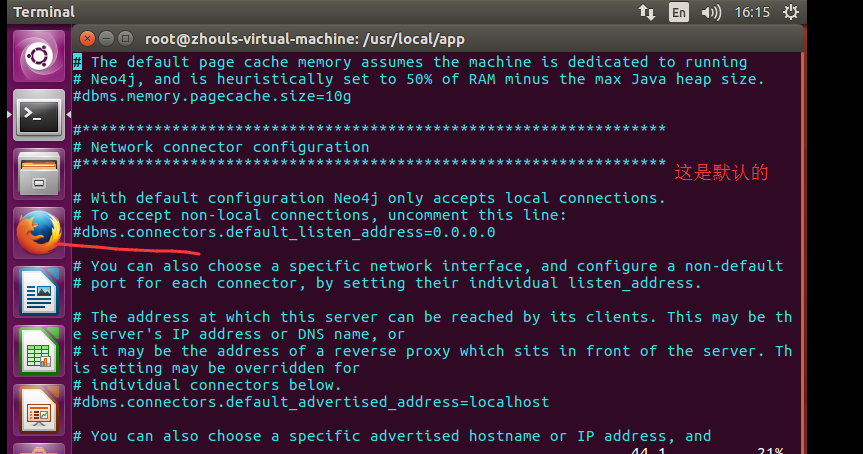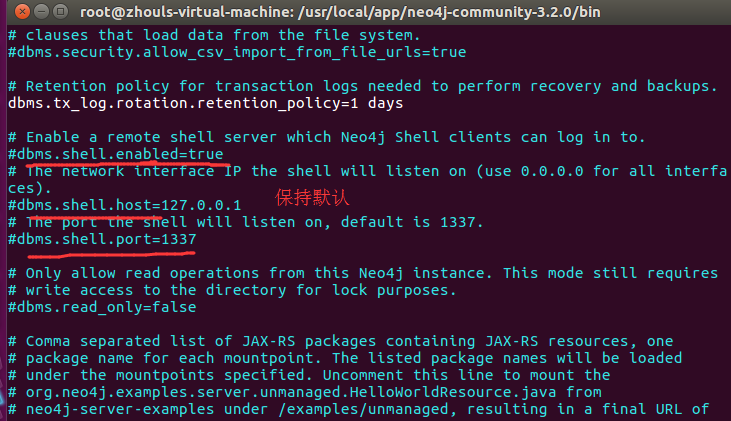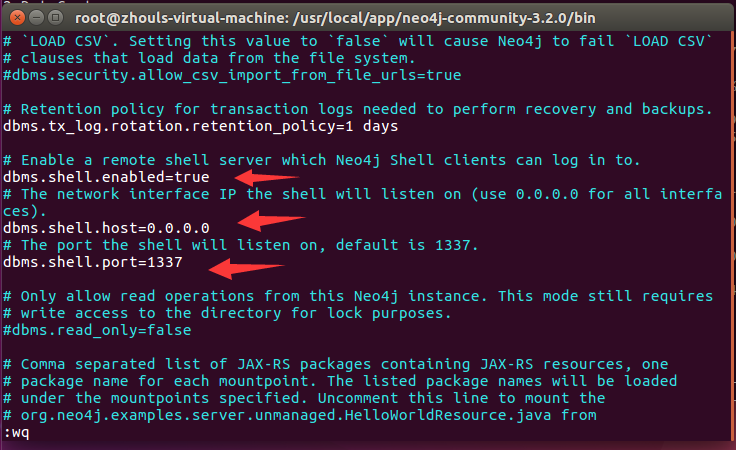neo4j的配置文件(图文详解)
不多说,直接上干货!
前期博客
Ubuntu16.04下Neo4j图数据库官网安装部署步骤(图文详解)(博主推荐)
Ubuntu14.04下Neo4j图数据库官网安装部署步骤(图文详解)(博主推荐)
neo4j的配置文件(默认的)
#*****************************************************************
# Neo4j configuration
#
# For more details and a complete list of settings, please see
# https://neo4j.com/docs/operations-manual/current/reference/configuration-settings/
#***************************************************************** # The name of the database to mount
#dbms.active_database=graph.db # Paths of directories in the installation.
#dbms.directories.data=data
#dbms.directories.plugins=plugins
#dbms.directories.certificates=certificates
#dbms.directories.logs=logs
#dbms.directories.lib=lib
#dbms.directories.run=run # This setting constrains all `LOAD CSV` import files to be under the `import` directory. Remove or comment it out to
# allow files to be loaded from anywhere in the filesystem; this introduces possible security problems. See the
# `LOAD CSV` section of the manual for details.
dbms.directories.import=import # Whether requests to Neo4j are authenticated.
# To disable authentication, uncomment this line
#dbms.security.auth_enabled=false # Enable this to be able to upgrade a store from an older version.
#dbms.allow_format_migration=true # Java Heap Size: by default the Java heap size is dynamically
# calculated based on available system resources.
# Uncomment these lines to set specific initial and maximum
# heap size.
#dbms.memory.heap.initial_size=512m
#dbms.memory.heap.max_size=512m # The amount of memory to use for mapping the store files, in bytes (or
# kilobytes with the 'k' suffix, megabytes with 'm' and gigabytes with 'g').
# If Neo4j is running on a dedicated server, then it is generally recommended
# to leave about - gigabytes for the operating system, give the JVM enough
# heap to hold all your transaction state and query context, and then leave the
# rest for the page cache.
# The default page cache memory assumes the machine is dedicated to running
# Neo4j, and is heuristically set to % of RAM minus the max Java heap size.
#dbms.memory.pagecache.size=10g #*****************************************************************
# Network connector configuration
#***************************************************************** # With default configuration Neo4j only accepts local connections.
# To accept non-local connections, uncomment this line:
#dbms.connectors.default_listen_address=0.0.0.0 # You can also choose a specific network interface, and configure a non-default
# port for each connector, by setting their individual listen_address. # The address at which this server can be reached by its clients. This may be the server's IP address or DNS name, or
# it may be the address of a reverse proxy which sits in front of the server. This setting may be overridden for
# individual connectors below.
#dbms.connectors.default_advertised_address=localhost # You can also choose a specific advertised hostname or IP address, and
# configure an advertised port for each connector, by setting their
# individual advertised_address. # Bolt connector
dbms.connector.bolt.enabled=true
#dbms.connector.bolt.tls_level=OPTIONAL
#dbms.connector.bolt.listen_address=: # HTTP Connector. There must be exactly one HTTP connector.
dbms.connector.http.enabled=true
#dbms.connector.http.listen_address=: # HTTPS Connector. There can be zero or one HTTPS connectors.
dbms.connector.https.enabled=true
#dbms.connector.https.listen_address=: # Number of Neo4j worker threads.
#dbms.threads.worker_count= #*****************************************************************
# Logging configuration
#***************************************************************** # To enable HTTP logging, uncomment this line
#dbms.logs.http.enabled=true # Number of HTTP logs to keep.
#dbms.logs.http.rotation.keep_number= # Size of each HTTP log that is kept.
#dbms.logs.http.rotation.size=20m # To enable GC Logging, uncomment this line
#dbms.logs.gc.enabled=true # GC Logging Options
# see http://docs.oracle.com/cd/E19957-01/819-0084-10/pt_tuningjava.html#wp57013 for more information.
#dbms.logs.gc.options=-XX:+PrintGCDetails -XX:+PrintGCDateStamps -XX:+PrintGCApplicationStoppedTime -XX:+PrintPromotionFailure -XX:+PrintTenuringDistribution # Number of GC logs to keep.
#dbms.logs.gc.rotation.keep_number= # Size of each GC log that is kept.
#dbms.logs.gc.rotation.size=20m # Size threshold for rotation of the debug log. If set to zero then no rotation will occur. Accepts a binary suffix "k",
# "m" or "g".
#dbms.logs.debug.rotation.size=20m # Maximum number of history files for the internal log.
#dbms.logs.debug.rotation.keep_number= #*****************************************************************
# Miscellaneous configuration
#***************************************************************** # Enable this to specify a parser other than the default one.
#cypher.default_language_version=3.0 # Determines if Cypher will allow using file URLs when loading data using
# `LOAD CSV`. Setting this value to `false` will cause Neo4j to fail `LOAD CSV`
# clauses that load data from the file system.
#dbms.security.allow_csv_import_from_file_urls=true # Retention policy for transaction logs needed to perform recovery and backups.
dbms.tx_log.rotation.retention_policy= days # Enable a remote shell server which Neo4j Shell clients can log in to.
#dbms.shell.enabled=true (远程访问,需要时可以放开)
# The network interface IP the shell will listen on (use 0.0.0.0 for all interfaces).
#dbms.shell.host=127.0.0.1 (远程访问的机器地址,需要时可以放开,为0.0.0.0)
# The port the shell will listen on, default is .
#dbms.shell.port=1337 (远程访问端口,需要时可以放开) # Only allow read operations from this Neo4j instance. This mode still requires
# write access to the directory for lock purposes.
#dbms.read_only=false # Comma separated list of JAX-RS packages containing JAX-RS resources, one
# package name for each mountpoint. The listed package names will be loaded
# under the mountpoints specified. Uncomment this line to mount the
# org.neo4j.examples.server.unmanaged.HelloWorldResource.java from
# neo4j-server-examples under /examples/unmanaged, resulting in a final URL of
# http://localhost:7474/examples/unmanaged/helloworld/{nodeId}
#dbms.unmanaged_extension_classes=org.neo4j.examples.server.unmanaged=/examples/unmanaged #********************************************************************
# JVM Parameters
#******************************************************************** # G1GC generally strikes a good balance between throughput and tail
# latency, without too much tuning.
dbms.jvm.additional=-XX:+UseG1GC # Have common exceptions keep producing stack traces, so they can be
# debugged regardless of how often logs are rotated.
dbms.jvm.additional=-XX:-OmitStackTraceInFastThrow # Make sure that `initmemory` is not only allocated, but committed to
# the process, before starting the database. This reduces memory
# fragmentation, increasing the effectiveness of transparent huge
# pages. It also reduces the possibility of seeing performance drop
# due to heap-growing GC events, where a decrease in available page
# cache leads to an increase in mean IO response time.
# Try reducing the heap memory, if this flag degrades performance.
dbms.jvm.additional=-XX:+AlwaysPreTouch # Trust that non-static final fields are really final.
# This allows more optimizations and improves overall performance.
# NOTE: Disable this if you use embedded mode, or have extensions or dependencies that may use reflection or
# serialization to change the value of final fields!
dbms.jvm.additional=-XX:+UnlockExperimentalVMOptions
dbms.jvm.additional=-XX:+TrustFinalNonStaticFields # Disable explicit garbage collection, which is occasionally invoked by the JDK itself.
dbms.jvm.additional=-XX:+DisableExplicitGC # Remote JMX monitoring, uncomment and adjust the following lines as needed. Absolute paths to jmx.access and
# jmx.password files are required.
# Also make sure to update the jmx.access and jmx.password files with appropriate permission roles and passwords,
# the shipped configuration contains only a read only role called 'monitor' with password 'Neo4j'.
# For more details, see: http://download.oracle.com/javase/8/docs/technotes/guides/management/agent.html
# On Unix based systems the jmx.password file needs to be owned by the user that will run the server,
# and have permissions set to .
# For details on setting these file permissions on Windows see:
# http://docs.oracle.com/javase/8/docs/technotes/guides/management/security-windows.html
#dbms.jvm.additional=-Dcom.sun.management.jmxremote.port=
#dbms.jvm.additional=-Dcom.sun.management.jmxremote.authenticate=true
#dbms.jvm.additional=-Dcom.sun.management.jmxremote.ssl=false
#dbms.jvm.additional=-Dcom.sun.management.jmxremote.password.file=/absolute/path/to/conf/jmx.password
#dbms.jvm.additional=-Dcom.sun.management.jmxremote.access.file=/absolute/path/to/conf/jmx.access # Some systems cannot discover host name automatically, and need this line configured:
#dbms.jvm.additional=-Djava.rmi.server.hostname=$THE_NEO4J_SERVER_HOSTNAME # Expand Diffie Hellman (DH) key size from default to for DH-RSA cipher suites used in server TLS handshakes.
# This is to protect the server from any potential passive eavesdropping.
dbms.jvm.additional=-Djdk.tls.ephemeralDHKeySize= #********************************************************************
# Wrapper Windows NT/2000/XP Service Properties
#********************************************************************
# WARNING - Do not modify any of these properties when an application
# using this configuration file has been installed as a service.
# Please uninstall the service before modifying this section. The
# service can then be reinstalled. # Name of the service
dbms.windows_service_name=neo4j #********************************************************************
# Other Neo4j system properties
#********************************************************************
dbms.jvm.additional=-Dunsupported.dbms.udc.source=tarball
~
一、
由

# With default configuration Neo4j only accepts local connections.
# To accept non-local connections, uncomment this line:
# dbms.connectors.default_listen_address=0.0.0.0
变成

# With default configuration Neo4j only accepts local connections.
# To accept non-local connections, uncomment this line:
dbms.connectors.default_listen_address=0.0.0.0
二、
由

# Enable a remote shell server which Neo4j Shell clients can log in to.
#dbms.shell.enabled=true
# The network interface IP the shell will listen on (use 0.0.0.0 for all interfaces).
#dbms.shell.host=127.0.0.1
# The port the shell will listen on, default is .
#dbms.shell.port=
改成

# Enable a remote shell server which Neo4j Shell clients can log in to.
dbms.shell.enabled=true
# The network interface IP the shell will listen on (use 0.0.0.0 for all interfaces).
dbms.shell.host=0.0.0.0
# The port the shell will listen on, default is .
dbms.shell.port=
neo4j的配置文件(图文详解)的更多相关文章
- Ubuntu14.04下沙盒数据导入到 Neo4j 数据库(图文详解)
不多说,直接上干货! 参考博客 http://blog.csdn.net/u012318074/article/details/72793914 (表示感谢) 前期博客 Neo4j沙盒实验申请过程 ...
- Ubuntu16.04下沙盒数据导入到 Neo4j 数据库(图文详解)
不多说,直接上干货! 参考博客 http://blog.csdn.net/u012318074/article/details/72793914 (表示感谢) 前期博客 Neo4j沙盒实验申请过 ...
- Ubuntu16.04下Neo4j图数据库官网安装部署步骤(图文详解)(博主推荐)
不多说,直接上干货! 说在前面的话 首先,查看下你的操作系统的版本. root@zhouls-virtual-machine:~# cat /etc/issue Ubuntu LTS \n \l r ...
- Ubuntu14.04下Neo4j图数据库官网安装部署步骤(图文详解)(博主推荐)
不多说,直接上干货! 说在前面的话 首先,查看下你的操作系统的版本. root@zhouls-virtual-machine:~# cat /etc/issue Ubuntu 14.04.4 LTS ...
- 全网最详细的hive-site.xml配置文件里如何添加达到Hive与HBase的集成,即Hive通过这些参数去连接HBase(图文详解)
不多说,直接上干货! 一般,普通的情况是 全网最详细的hive-site.xml配置文件里添加<name>hive.cli.print.header</name>和<na ...
- HUE配置文件hue.ini 的hbase模块详解(图文详解)(分HA集群和非HA集群)
不多说,直接上干货! 我的集群机器情况是 bigdatamaster(192.168.80.10).bigdataslave1(192.168.80.11)和bigdataslave2(192.168 ...
- suricata.yaml (一款高性能的网络IDS、IPS和网络安全监控引擎)默认配置文件(图文详解)
不多说,直接上干货! 前期博客 基于CentOS6.5下Suricata(一款高性能的网络IDS.IPS和网络安全监控引擎)的搭建(图文详解)(博主推荐) 或者 基于Ubuntu14.04下Suric ...
- kafka的server.properties配置文件参考示范(图文详解)(多种方式)
简单点的,就是 kafka_2.11-0.8.2.2.tgz的3节点集群的下载.安装和配置(图文详解) 但是呢,大家在实际工作中,会一定要去牵扯到调参数和调优问题的.以下,是我给大家分享的kafka的 ...
- Neo4j沙盒实验申请过程步骤(图文详解)
不多说,直接上干货! 参考博客 http://blog.csdn.net/u012318074/article/details/72793632 (对此表示感谢) 前期博客 我暂时是将Neo4j ...
随机推荐
- 浅尝一致性Hash原理
写在前面 在解决分布式系统中负载均衡的问题时候可以使用Hash算法让固定的一部分请求落到同一台服务器上,这样每台服务器固定处理一部分请求(并维护这些请求的信息),起到负载均衡的作用.但是普通的余数ha ...
- 高性能server分析 - Hadoop的RpcServer
一.Listener Listener线程,当Server处于运行状态时,其负责监听来自客户端的连接,并使用Select模式处理Accept事件. 同时,它开启了一个空闲连接(Idle Connect ...
- java将文件打包成ZIP压缩文件的工具类实例
package com.lanp; import java.io.BufferedInputStream; import java.io.BufferedOutputStream; import ja ...
- Freescale OSBDM JM60仿真器 BGND Interface
The BGND interface provides the standard 6 pin connection for the single wire BGND signal type devel ...
- Gef最简单入门-HelloWold(2)
ok .上代码 模型类 package testgef.model; public class HelloModel { private String text = "Hello word& ...
- Google 镜像站搜集
在特殊的地方和特殊的时间,流畅顺利的打开一个网站也变得如此艰难. 2016.01.16 更新.本站订阅更新功能已上线,欢迎订阅! 以下是直接使用谷歌的方法,如需***戳这里(VPN | Shadows ...
- WCF Routing服务,负载均衡
WCF4.0支持路由机制,通过RoutingService实现请求分发.拦截处理. 一.应用场景 1.暴露一个endpoint在外网,其余服务部署于内网: 2.请求分发,能对服务做负载功能: 二.WC ...
- 如何在Windows服务程序中添加U盘插拔的消息
研究了下这个问题,主要要在一般的windows服务程序中修改两个地方: 一.调用RegisterServiceCtrlHandlerEx VOID WINAPI SvcMain( DWORD dwAr ...
- javascript:addEventListener
addEventListener 用于注册事件处理程序,IE 中为 attachEvent,我们为什么讲 addEventListener 而不讲 attachEvent 呢?一来 attachEve ...
- Oracle Applications Documentation
Oracle E-Business Suite Documentation Web Library Release 12.2+ Link Download Oracle E-Business Suit ...
